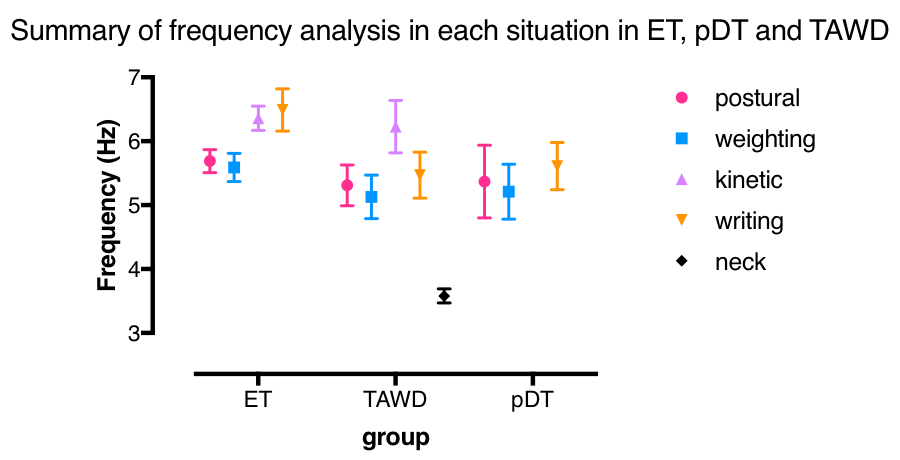Session Information
Date: Tuesday, June 6, 2017
Session Title: Tremor
Session Time: 1:45pm-3:15pm
Location: Exhibit Hall C
Objective: To explore the characteristics of tremor in patients with ET and DT by using neurophysiologic measures.
Background: Tremor features in patients with essential tremor (ET) may be clinically indistinguishable from patients with dystonic tremor (DT) especially in those who have subtle dystonia.
Methods: 21 ET and 20 DT patients were studied. Patients with DT were subdivided into 12 patients with pure DT (pDT; writer’s cramp with writing tremor) and 8 patients with tremor associated with dystonia (TAWD; cervical dystonia with hand tremor). Hand tremors were measured by using an accelerometer and surface EMG of the flexor carpi radialis and extensor carpi radialis muscles bilaterally. The tremors were recorded in 4 situations including posture, posture with 1-pound weighting, kinetic and writing. Head tremors were recorded at the neck muscles in patients with TAWD and ET who had head tremor. Peak frequency of tremor (Hz) and magnitude (power; mV2) of the accelerometer signal and EMG were analyzed and compared among groups.
Results: All patients with essential tremor, as well as those with TAWD, had a central component of postural tremor. Only 3 of 12 patients (25%) with pDT had noticeable postural tremor on the dystonic side and all of them were also central tremors. The peak frequency of kinetic tremor was significantly higher than postural tremor but similar to writing tremor frequency in both ET and TAWD. Writing tremor was the only tremor in most of the pDT patients; the peak frequency of writing tremor in these patients was close to the frequency of postural tremor in those who had postural tremor. There were no differences in peak frequency in each situation among ET, TAWD and pDT. All TAWD patients had head tremors which were measurable in 6 of 8 patients (75%). Its peak frequency was slower than the postural and kinetic tremor. No measurable head tremor was noted in our ET cohort [figure1]. Peak frequency of postural, kinetic and writing tremor were negatively correlated with age of onset of tremor in ET and TAWD but not pDT [figure2].
Conclusions: Our study suggests that tremors in ET and TAWD share similar characteristics. All TAWD patients had head tremor in addition to cervical dystonia and hand tremors. Tremor in pDT is different from TAWD. It was manifest only in a specific task and later spread to posture only on the affected side. We propose that tremor in TAWD may be an overlap syndrome of both ET and dystonia.
To cite this abstract in AMA style:
P. Panyakaew, H.J. Cho, M. Hallett. Tremor Characteristics in Essential Tremor and Dystonic Tremor [abstract]. Mov Disord. 2017; 32 (suppl 2). https://www.mdsabstracts.org/abstract/tremor-characteristics-in-essential-tremor-and-dystonic-tremor/. Accessed May 15, 2025.« Back to 2017 International Congress
MDS Abstracts - https://www.mdsabstracts.org/abstract/tremor-characteristics-in-essential-tremor-and-dystonic-tremor/


